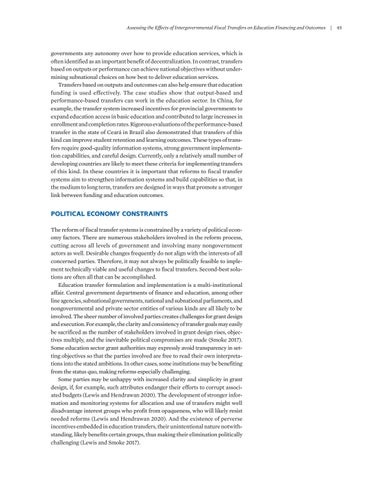Assessing the Effects of Intergovernmental Fiscal Transfers on Education Financing and Outcomes | 45
governments any autonomy over how to provide education services, which is often identified as an important benefit of decentralization. In contrast, transfers based on outputs or performance can achieve national objectives without undermining subnational choices on how best to deliver education services. Transfers based on outputs and outcomes can also help ensure that education funding is used effectively. The case studies show that output-based and performance-based transfers can work in the education sector. In China, for example, the transfer system increased incentives for provincial governments to expand education access in basic education and contributed to large increases in enrollment and completion rates. Rigorous evaluations of the performance-based transfer in the state of Ceará in Brazil also demonstrated that transfers of this kind can improve student retention and learning outcomes. These types of transfers require good-quality information systems, strong government implementation capabilities, and careful design. Currently, only a relatively small number of developing countries are likely to meet these criteria for implementing transfers of this kind. In these countries it is important that reforms to fiscal transfer systems aim to strengthen information systems and build capabilities so that, in the medium to long term, transfers are designed in ways that promote a stronger link between funding and education outcomes.
POLITICAL ECONOMY CONSTRAINTS The reform of fiscal transfer systems is constrained by a variety of political economy factors. There are numerous stakeholders involved in the reform process, cutting across all levels of government and involving many nongovernment actors as well. Desirable changes frequently do not align with the interests of all concerned parties. Therefore, it may not always be politically feasible to implement technically viable and useful changes to fiscal transfers. Second-best solutions are often all that can be accomplished. Education transfer formulation and implementation is a multi-institutional affair. Central government departments of finance and education, among other line agencies, subnational governments, national and subnational parliaments, and nongovernmental and private sector entities of various kinds are all likely to be involved. The sheer number of involved parties creates challenges for grant design and execution. For example, the clarity and consistency of transfer goals may easily be sacrificed as the number of stakeholders involved in grant design rises, objectives multiply, and the inevitable political compromises are made (Smoke 2017). Some education sector grant authorities may expressly avoid transparency in setting objectives so that the parties involved are free to read their own interpretations into the stated ambitions. In other cases, some institutions may be benefiting from the status quo, making reforms especially challenging. Some parties may be unhappy with increased clarity and simplicity in grant design, if, for example, such attributes endanger their efforts to corrupt associated budgets (Lewis and Hendrawan 2020). The development of stronger information and monitoring systems for allocation and use of transfers might well disadvantage interest groups who profit from opaqueness, who will likely resist needed reforms (Lewis and Hendrawan 2020). And the existence of perverse incentives embedded in education transfers, their unintentional nature notwithstanding, likely benefits certain groups, thus making their elimination politically challenging (Lewis and Smoke 2017).






